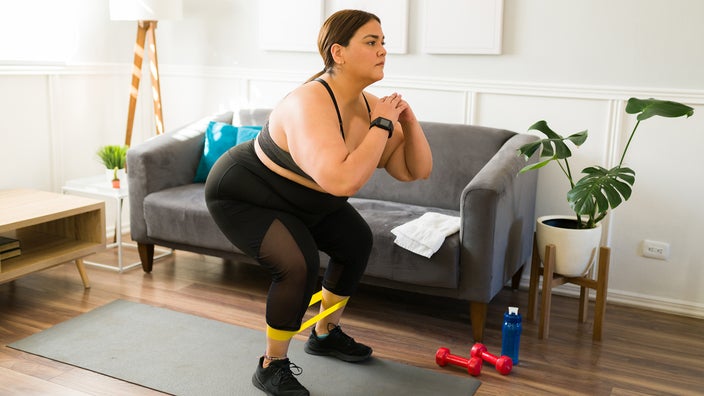
Will Working Out Twice a Day Help You Reach Your Fitness Goals Faster?
Key takeaways:
Working out twice a day may help you reach fitness goals — like building muscle — faster.
But a two-a-day workout schedule can also lead to injury or overtraining. Beginners should focus on gradually increasing physical activity throughout the day.
Proper recovery and nutrition are key to maximizing the benefits of two-a-day workouts.
Table of contents

Working out twice a day isn’t just for professional bodybuilders and athletes. This workout schedule can help you get more daily movement and reach your fitness goals. That said, two-a-days aren’t for everyone. And without proper planning, they could cause injuries that derail your training.
So how do you know if working out twice a day is right for you? Consider the benefits, risks, and key safety tips to help you find the answer.
Should you work out twice a day?
You may be able to add two-a-day workouts to your fitness plan safely. But whether or not you should, depends on your fitness level, goals, and schedule.
Search and compare options
Consider your fitness level
Two-a-day workouts are no longer limited to advanced exercisers and competitive athletes. But before you give it a try, consider your fitness level. This is particularly important for beginners or those returning to exercise after a break. Doing too much too soon is a common workout mistake. It can overtax your body and make it hard to recover.
Beginners shouldn’t rush into two-a-day workouts. Instead, try gradually increasing your physical activity throughout the day. For example, you could supplement your morning lifting workout with an evening stroll. Or, you could follow up yoga with foam rolling later in the day.
Moving your body more often can boost your fitness without straining your muscles. Over time, you can switch to more structured or challenging second workouts. Your evening stroll might eventually become a power-walking session.
Think about your goals
Experts recommend getting at least 150 minutes of moderate aerobic activity and 2 strength-training workouts every week. You can hit those targets — and reach various fitness goals — with one session a day. But if you already exercise regularly, are two-a-day workouts the best way to reach your fitness goals? When done correctly, exercising twice a day might bring you closer to your goals.
Say your goal is to lose weight. Adding more exercise to your routine will help you burn more calories, which may promote weight loss. But many lifestyle factors, including nutrition, affect weight management. Two-a-day workouts aren’t necessary for weight loss or other goals.
Exercise is more about heart health and overall fitness. Think about your "why" and plan your workouts accordingly. If you’re unsure about the best exercise schedule, consider talking to a personal trainer.
Planning to do cardio and strength training on the same day? Find out whether you should do cardio before or after weights.
Recovery is critical to your exercise routine. Try active recovery workouts to help your muscles bounce back from training sessions.
How can you tell if you’re overdoing it? Watch for these signs of overtraining and learn how to avoid it.
Take a look at your schedule
Your schedule is a crucial factor in deciding if you can manage two-a-days. For most people, sticking to one workout a day is hard enough. Moving up to twice-daily sessions may not be realistic or feasible.
If you struggle with workout motivation or your schedule is jam-packed, twice-daily sessions probably won’t work for you. But if you have trouble fitting in workouts multiple days a week, doubling up on fewer days could be a better fit.
What are the benefits of two-a-day workouts?
Exercising twice a day can improve conditioning and overall health — if you have a plan and create a routine that aligns with your needs. Here are some key benefits of two-a-day workouts.
Read more like this
Explore these related articles, suggested for readers like you.
You’ll be more active
Doing two workouts a day is a good way to stay active. That’s a critical benefit, considering that more than 70% of adults don’t get the recommended amount of weekly exercise. A sedentary or inactive lifestyle increases your risk of conditions such as heart disease, hypertension, and osteoporosis.
Increasing your daily physical activity may reduce those risks and help you live a healthier, longer life. A 2022 study found that adding just 10 minutes of daily exercise could prevent more than 110,000 premature deaths each year.
Being active also makes everyday tasks — like picking up a box, going up the steps, or spending all day on your feet — easier.
You may enjoy enhanced benefits of exercise
When it comes to exercise, some activity is always better than none. That same 2022 study also found that 75 minutes of moderate cardio per week may lower the risk of heart disease, stroke, and all-cause mortality. That’s half the expert-recommended minimum.
Going above and beyond those recommendations could enhance the benefits of regular exercise. Experts say that adults should aim for one of these weekly aerobics goals:
150 minutes of moderate aerobics
75 minutes of vigorous aerobics
In a large-scale study, researchers found that people who met these minimums lowered their risk of early death by up to 21%. But those who worked out two to four times more than the minimum reduced their risk by up to 31%. So, exercising twice a day could lead to even better health and longevity.
You may reach your fitness goals faster
There’s a reason why so many professional athletes ramp up their training schedules ahead of a new season. Research suggests that training twice daily could help you reach fitness goals — like building muscle — faster.
In a small study, researchers compared single and twice-daily strength-training workouts in active men. Those who exercised twice a day had more lower body strength. But it didn’t affect upper body muscle strength, endurance, or growth.
Reaching your goals faster isn’t a guarantee. Keep in mind that athletes work with coaches and trainers. If you double up on your daily training sessions, do so thoughtfully and with an emphasis on health.
What are the risks of working out twice a day?
Two-a-day workouts can increase your risk of overtraining or injury. That’s because too much exercise — without adequate recovery, rest, or nutrition — can take a toll on your body.
Overtraining can cause a host of symptoms, including:
Muscle pain
Low energy
Slower exercise recovery
Poor sleep quality
Weakened immune system
These effects could harm your health and delay your training progress. Not to mention, this exercise schedule requires more commitment and can be time-consuming. So, exercising twice a day could lead to burnout.
It’s so important to be intentional about your training, including prioritizing recovery and rest days.
How do you split two-a-day workouts?
Everyone’s needs differ, so there’s no one-size-fits-all approach for a two-a-day training schedule. However, if you exercise regularly, you can use these tips to structure your two-a-day workout plan.
Do your hardest workout first
Start with your higher-intensity workout. Then, follow it with a less strenuous activity later in the day. You may have more energy and focus earlier in the day. That could make it easier to concentrate on proper form and give your best effort during a challenging workout.
Space your workouts 6 hours apart
Exercise scientists suggest taking at least 6 hours between vigorous cardio and strength-training workouts. This allows your muscles to start recovering. It can also help you reap the benefits of two-a-days while minimizing the risk of injury.
Try a cross-training or active recovery workout after your first session
Consider following your vigorous sweat session with a cross-training or active recovery workout. With cross-training, you include different types of exercise in your training plan. For example, you could start with an upper body resistance workout and cross train with a lower body cardio routine later. That way, you won’t overwork the same muscle groups.
You can also follow up with an active recovery session. Active recovery, or lower-intensity exercise, can reduce lactic acid buildup in your muscles and lessen muscle aches or fatigue after a vigorous workout. But consult a healthcare professional if you have severe pain or notice signs of injury.
Focus on proper nutrition and hydration between workouts
Training twice a day is physically taxing. Proper nutrition and adequate hydration help your body manage the extra physical stress. This includes balanced meals, healthy snacks, and water to fuel your workouts and support recovery.
If your new training schedule leaves you with less time for meal prep, keep nutritious foods — like oatmeal, hard-boiled eggs, or energy balls — to make fueling up quick and easy.
Get lots of rest
Your muscles may recover, adapt, and grow after exercise. That means many exercise benefits are locked in during rest and recovery days. Make sure to include one to three rest days into your weekly training plan. And be sure to get at least 7 to 9 hours of sleep every night. Try to avoid strenuous workouts before bed. Research suggests that vigorous exercise less than an hour before bed can hurt your sleep quality.
Listen to your body
It can be frustrating to stop working out when you’re in a good rhythm. But nothing disrupts your rhythm like an injury or illness. Listen to your body and take a break when needed. Remember that ultimately, you’re exercising to maintain your health. Taking a break now could help you avoid longer training delays later.
Frequently asked questions
Experts recommend resistance training two to three times a week to build or strengthen muscles. Try to find a training schedule that suits your needs, and include one to three rest days between sessions.
Most people don’t need to lift weights twice daily to reach their fitness goals. Doing so can increase your risk of injury and overtraining. But experienced athletes and weightlifters may be able to do a twice-daily resistance training plan safely.
No, you don't have to avoid working out at night. While vigorous exercise too close to bedtime may disrupt your sleep, some research suggests that less intense exercise before bed may support better sleep quality.
The bottom line
You don’t have to be a pro-level athlete to benefit from working out more. Two-a-day workouts can be an effective way to improve conditioning and meet your fitness goals. But beginners shouldn’t jump into working out twice a day. Doing so could cause injury or overtraining.
People new to exercise can benefit from gradually increasing physical activity throughout their day. When you’re ready to move up to twice-daily sessions, prioritize rest, recovery, and proper nutrition.
Why trust our experts?



References
Andrade-Souza, V. A., et al. (2019). Exercise twice-a-day potentiates markers of mitochondrial biogenesis in men. The FASEB Journal.
Centers for Disease Control and Prevention. (2023). Adult activity: An overview.
Corrêa, D. A., et al. (2022). Twice-daily sessions result in a greater muscle strength and a similar muscle hypertrophy compared to once-daily session in resistance-trained men. The Journal of Sports Medicine and Physical Fitness.
Lee, D. H., et al. (2022). Long-term leisure-time physical activity intensity and all-cause and cause-specific mortality: A prospective cohort of US adults. Circulation.
National Center for Health Statistics. (2022). Exercise or physical activity. Centers for Disease Control and Prevention.
Park, J. H., et al. (2020). Sedentary lifestyle: Overview of updated evidence of potential health risks. Korean Journal of Family Medicine.
Reimers, C. D., et al. (2012). Does physical activity increase life expectancy? A review of the literature. Journal of Aging Research.
Robineau, J., et al. (2016). Specific training effects of concurrent aerobic and strength exercises depend on recovery duration. The Journal of Strength and Conditioning Research.
Roman, W., et al. (2021). Muscle repair after physiological damage relies on nuclear migration for cellular reconstruction. Science.
Saint-Maurice, P. F., et al. (2022). Estimated number of deaths prevented through increased physical activity among US adults. JAMA Internal Medicine.
Singh, F., et al. (2019). ACSM guidelines for strength training. American College of Sports Medicine.
Stutz, J., et al. (2019). Effects of evening exercise on sleep in healthy participants: A systematic review and meta-analysis. Sports Medicine.
Yue, T., et al. (2022). Different intensities of evening exercise on sleep in healthy adults: A systematic review and network meta-analysis. Nature and Science of Sleep.


























